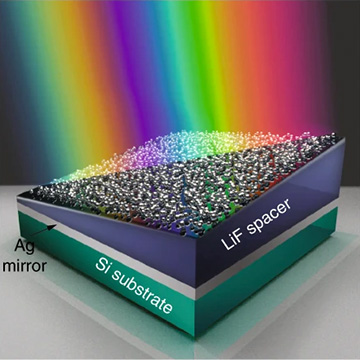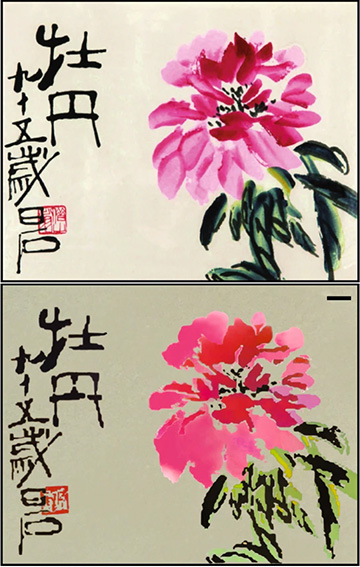
A team of scientists in the U.K. and China built a structure involving gold nanoclusters, a transparent dielectric spacer with gradually varying thickness, and a silver mirror to create a system for tunable structural colors. [Image: Mao et al., Nat. Commun., doi: 10.1038/s41467-020-15349-y (2020); CC-BY 4.0]
From the bright-white scales of a beetle to the jet-black wings of a bird of paradise, the animal kingdom contains nearly every color imaginable. While many come from light-absorbing pigments in tissues, others originate from the interference effects of tiny structures, invisible to the naked eye, on scales or feathers.
In a new study, a team of researchers from the United Kingdom and China explored a way to make such nanostructures tunable to produce a broad range of different colors (Nat. Commun., doi: 10.1038/s41467-020-15349-y). The technology opens the doors for potential applications such as non-toxic pigments and backlight-free dynamic color displays.
Color without pigment
Structural coloration creates colors without the use of dye or pigment. Instead, a pattern of nanostructures such as holes, fibers or ridges reflects or scatters light so that waves of certain frequencies can constructively interfere.
Examples of structural coloration abound in nature. Peacock tails have brown pigmentation, but appear blue, turquoise and green due to photonic structures in the branches of each feather. The wings of the black butterfly Pachliopta aristolochiae have a design based on disordered nanoholes that efficiently absorb light over a wide spectral range. Similarly, the white stripes of the pyjama squid are colored by multilayer reflectors in a disordered arrangement that reflects diffuse white light.
Taking inspiration from such natural examples, Changxu Liu, a former postdoctoral researcher at the University of Birmingham, U.K., and his colleagues wanted to control the way light passes through artificial disordered nanostructures, to produce tunable colors.
Disordered nanoclusters
The researchers started with a theoretical analysis based on coupled-mode theory, followed by 3D full-wave simulations. Their aim was to model a disordered system that can freely transition from broadband absorption—similar to the black wings of P. aristolochiae—to band-limited reflection/transmission (that is, colors).

To highlight the feasibility of colorful pattern generation, the researchers used their disordered system to fabricate a structure (bottom) that produced the color pattern of the Chinese watercolor painting “The Peony Flower” by Baishi Qi (top). Scale bar: 10 mm. [Image: Mao et al., Nat. Commun., doi: 10.1038/s41467-020-15349-y (2020); CC-BY 4.0]
Based on the model results, the team designed an experimental setup. Gold nanoclusters were deposited on top of a transparent dielectric, and a mirror was placed on the bottom to create an optical cavity. The randomized shapes and positions of the nanoclusters, which arise naturally as a result of the gas-phase cluster beam deposition technique, provides the necessary disorder.
“We achieved the tunability by changing the optical environment that the disordered system is embedded in—such as by simply introducing a transparent optical cavity to the system,” said Liu. “As a result, vivid color can be generated, which can be tuned by varying the thickness of the optical cavity.”
Re-creating a watercolor
A thin cavity creates broadband absorption; as it is gradually increased in thickness, the system enters a regime of rainbow-like color variation. The authors even re-created a Chinese watercolor painting, “The Peony Flower” by Baishi Qi, with their system to demonstrate the feasibility of colorful pattern generation.
“Compared to dyes, structural coloration is much more stable against high temperature and corrosion,” said Liu. “And compared to other structural coloration from nanostructures formed by sophisticated lithography-based fabrication, disordered systems can be produced at very large scale, at a much lower cost.”
